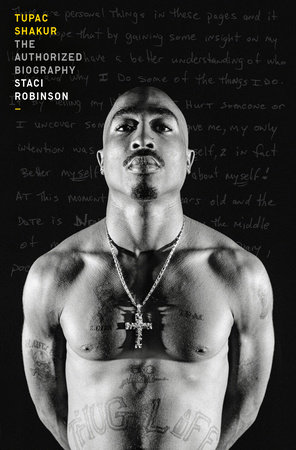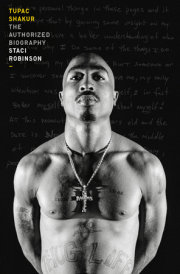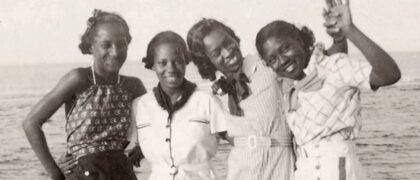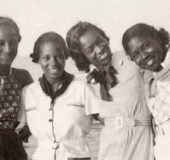Cradle to the Grave1970–1971
June 16, 1971, Mama gave birth to a hell raisin’ heavenly son. —
Tupac ShakurIn the predawn hour of April 2, 1969, Afeni Shakur and her husband, Lumumba, lay asleep in their apartment on 112 West 117th Street in Harlem. A hard, almost violent pounding on the front door woke them. Five cops, including Detective Francis Dalton from the New York Police Department, stood outside. Dalton, armed and strapped in a bulletproof vest, lit a rag on fire.
The officers yelled, “Fire! Open the door! Get out! Fire, Fire!”
Afeni, with her petite frame, smooth brown skin, and tiny, neat afro, woke to the noise. Still groggy, she followed Lumumba through the darkness and warily stumbled toward the front door. She looked through the peephole and saw smoke. As section leaders for the New York branch of the Black Panther Party, an organization that had for the past two years been under siege by the U.S. government, they were alarmed but also highly suspicious. They feared it was a setup.
Lumumba unlocked and cracked the door, Afeni close by his side. Quickly, the door swung in on them. Visions of men with guns flashed before their eyes. One gun shoved to Afeni’s stomach, another to Lumumba’s forehead.
“Police! If you move, I’ll blow your f***in’ brains open!”
Afeni and Lumumba surrendered. Handcuffed, they were hustled outside to the waiting police car and taken to the District Attorney’s Office, where they were booked and processed. As more members of the Black Panthers arrived at the office, handcuffed and perplexed, Afeni tried to make sense of what was happening. She soon learned that men she had trusted, who had stood beside her as Black Panther comrades and taken oaths of solidarity, vowing to fight for social justice, were actually undercover cops and instrumental in the arrests. One man in particular, Yedwa Sutan, whom she had questioned and tried to warn her fellow Panthers about, she learned was police officer Detective Ralph White, validating Afeni’s suspicions and marking the beginning of what would become a lifelong “trust nobody” mentality.
White and the other arresting officers were the NYPD’s Bureau of Special Services and Investigations Unit, known as BOSSI, a decades-old undercover intelligence operation that worked in conjunction with FBI director J. Edgar Hoover’s Counter Intelligence Program (COINTELPRO). The program was a clandestine effort to spy on and infiltrate “disruptors” of American society. Hoover considered the Black Panther Party a “subversive” group, publicly declaring them “the greatest threat to the internal security of the United States of America” and claiming they would be extinguished by the end of that year. He released aggressive directives that included the use of informants to work undercover operations and neutralize Panther leaders in order to prevent the spread of their “radical” teachings. He vowed to break up all efforts at solidarity with regard to the ideologies of Black nationalism, to prevent the rise of a “Black Messiah who could unify and electrify,” and to prevent Black leaders “from gaining respectability by discrediting them.” By 1969, hundreds of Black Panther members across the country had been targeted and arrested.
Out of the twenty-one Panthers targeted in this particular raid, Afeni, Lumumba, and ten others (plus two who were already in jail and four who were arrested later) were booked and indicted on charges of conspiracy to blow up a commuter railroad’s right-of-way, the Bronx Botanical Gardens, and five department stores: Abercrombie & Fitch, Macy’s, Alexander’s, Korvette’s, and Bloomingdale’s. All were New York landmarks and symbols of American capitalism. That afternoon the Panthers were shuffled off to eight different jails in New York and neighboring states, where they would await one of the most significant trials in African American legal history: The People of the State of New York v. Lumumba Shakur et al., which became widely known as the Trial of the Panther 21.
Arriving into the tumult of a postwar America still suffering under Jim Crow, Afeni, born Alice Faye Williams, was ushered into the world on January 10, 1947. That year would see the dawn of the Cold War and the establishment of the CIA. It also saw the unveiling of America’s first Polaroid camera. Tupperware was invented, and a loaf of bread cost twelve cents. And even as Jackie Robinson took the field as a Brooklyn Dodger, becoming the first African American to step onto a professional baseball field, the Ku Klux Klan ruled much of the Southern landscape. Delivered at home with the help of a midwife, Afeni was welcomed by her mother, Rosa Belle; father, Walter Williams, Jr.; and two-year-old sister, Gloria Jean, who mostly went by her middle name.
By the time Alice Faye was a mere six years old, life had already handed down to her the fundamental lessons of being Black in America. Alice and her sister walked to school each morning, down the dusty roads of Lumberton, North Carolina, enduring name-calling from white men driving by, slowing down long enough to bark hate-filled words at them. Some days it was “monkey.” Some days it was “bald-headed, skinny tar baby.” But most days it was “nigger.” Morning after morning, these words shot straight into young Alice’s psyche like daggers, proving that the effects of hate can cut deeper than a bullet or a knife.
In 1954, when Alice was seven years old, the Supreme Court landmark ruling Brown v. Board of Education swept through America like a quiet storm. Another step toward equality, but the world knew Black Americans—and more specifically Black students—would be met with violent backlash. In North Carolina, the Ku Klux Klan responded by rallying their forces around their message of hate. They sought to terrorize both Black and indigenous communities in the South, posting flyers, burning crosses, and lynching innocent people to discourage race mixing and to intimidate Blacks and Native tribes against continuing their quest for civil rights.
As the years passed, the Klan’s terrorist threats moved closer to the Williams home. In January 1958, news reached Lumberton that a Klan rally was planned in the nearby town of Maxton. The organization’s grand dragon, James W. “Catfish” Cole, was leading the charge, making it known that his primary goal was to “put Indians in their place and to end race-mixing” once and for all.
The night of January 18, over five hundred Lumbee warriors showed up in Maxton with guns and rifles, ready to defend themselves, overwhelming the fifty or so Klansmen who came for the rally. Shots were fired into the darkness, local police showed up, and the Ku Klux Klan bolted away into the dark night.
They never returned to Lumberton or Maxton again. Even before Alice Faye Williams was a Shakur, resistance and bold defiance was no abstraction to the Williams family.
But what came to be known as the Battle of Hayes Pond may very well have been the life event that shifted Alice into a new consciousness. The news sparked Alice’s emotions and allowed her to see that you didn’t always have to lie down in the face of attempted oppression. Through the Lumbee warriors’ victory, she learned at eleven years old that it was possible to say no—to stand up against unfair treatment. “That was my first taste of resistance,” she would recall forty-five years later. “Resistance is what I felt. Resist. A sense of ‘don’t let that happen to you.’ ”
Alice also saw her mother resist after suffering years of domestic violence. “When I used to come home from school, first and second grade, I would look under the bed to make sure [my father] hadn’t killed my mother and stuffed her body under there,” she recalled. But in 1959, Rosa Belle left her husband and moved her girls “up the road” to New York City. In doing so, they took part—along with 6 million other African Americans over the course of a sixty-year time span—in what came to be known as the Great Migration, a search for a life away from the rampant lynchings and social terror that plagued the lives of Black Americans in Southern states. Lured by the promise of a society that might offer a path to truly equal economic opportunity, Rosa Belle was hopeful. She found a room for the three of them to share in a white woman’s apartment on Brook Avenue in the Bronx.
But Alice Faye quickly discovered that the North wasn’t what she had hoped for. From the moment she stepped foot onto her new school campus, the name-calling resumed. When one schoolmate said she looked like something from outer space, she resisted in the way she knew how. “I kicked his ass,” she recalled. “All I wanted to do is fight. Fight back . . . I thought fighting was the way to compensate for my inadequacies.”
Copyright © 2023 by Staci Robinson. All rights reserved. No part of this excerpt may be reproduced or reprinted without permission in writing from the publisher.












